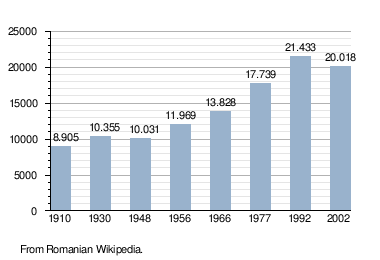Gheorgheni
| Gheorgheni Gyergyószentmiklós | |||
|---|---|---|---|
| Municipality | |||
 | |||
| |||
 Location of Gheorgheni | |||
| Coordinates: 46°43′12″N 25°35′24″E / 46.72000°N 25.59000°ECoordinates: 46°43′12″N 25°35′24″E / 46.72000°N 25.59000°E | |||
| Country |
| ||
| County | Harghita County | ||
| Status | Municipality | ||
| Government | |||
| • Mayor | János Mezei (Hungarian Civic Party) | ||
| Area | |||
| • Total | 90.17 km2 (34.81 sq mi) | ||
| Elevation | 816 m (2,677 ft) | ||
| Population (2011) | |||
| • Total | 18,377 | ||
| • Density | 200/km2 (530/sq mi) | ||
| Ethnicity | |||
| • Hungarians | 87.54% | ||
| • Romanians | 10.79% | ||
| Time zone | EET (UTC+2) | ||
| • Summer (DST) | EEST (UTC+3) | ||
| Postal code | 535500 | ||
| Area code(s) | (+40) 02 66 | ||
| Vehicle registration | HR | ||
| Website |
www | ||
Gheorgheni (Romanian pronunciation: [ɡe̯orˈɡenʲ]; Hungarian: Gyergyószentmiklós Hungarian pronunciation: [ˈɟɛrɟoːsɛntmikloːʃ]) is a city in Harghita County, Romania. It lies in the Székely Land, an ethno-cultural region in eastern Transylvania. The city administers four villages:
- Covacipeter / Kovácspéter
- Lacu Roşu / Gyilkostó
- Vargatac / Vargatag
- Visafolio / Visszafolyó
Nearby are two spectacular natural sites, the beautiful mountain lake Red Lake and Cheile Bicazului, a dramatic narrow canyon through the Eastern Carpathian Mountains forming the border with Neamţ County.
History

The city historically formed part of the Székely Land region of Transylvania province. It was first mentioned in 1332. It belonged to the Kingdom of Hungary, to the Principality of Transylvania (1557–1765) and the Grand Duchy of Transylvania (1765–1867). Between 1867–1918 it fell within the Kingdom of Hungary. Administratively, the town belonged to Gyergyószék, then, from 1876 until 1918 to the Csík County in the Austria-Hungary. After World War I, by the terms of the Treaty of Trianon of 1920, it became part of Romania and fall within Ciuc County. As a result of the Second Vienna Award, it belonged to Hungary again between 1940 and 1944. After World War II, it came under Romanian administration and became part of Romania in 1947. Between 1952 and 1960, it formed part of the Hungarian Autonomous Province, then, of the Mureş-Hungarian Autonomous Province until it was abolished in 1968. Since then, the commune is part of Harghita County.
Demographics
As of 2011, the city had a population of 17,705, of which 86.13% (15,250) are Székely Hungarians forming a majority. 1,988 or 11.22% are Romanians. Demographic movement according to the censuses:

Politics
The City Council has 17 members:
| Party | Seats | Current Council | |||||||||||
|---|---|---|---|---|---|---|---|---|---|---|---|---|---|
| Hungarian Civic Party | 11 | ||||||||||||
| Democratic Union of Hungarians in Romania | 6 | ||||||||||||
Twinnings
-
 Békés, Hungary
Békés, Hungary -
 Budapest 17th District, Hungary
Budapest 17th District, Hungary -
 Cegléd, Hungary
Cegléd, Hungary -
 Eger, Hungary
Eger, Hungary -
 Kiskunmajsa, Hungary
Kiskunmajsa, Hungary -
 Siófok, Hungary
Siófok, Hungary -
 Szigetszentmiklós, Hungary
Szigetszentmiklós, Hungary -
 Bačka Topola, Serbia
Bačka Topola, Serbia
References
| Wikimedia Commons has media related to Gheorgheni. |


